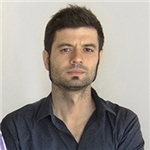La arquitectura siempre ha tenido un espíritu viajero. Los edificios y ciudades se han valido de la herramienta más eficaz de cada momento para llegar a otros lugares. Dibujos, croquis, grabados, planos, pinturas, etc., han sido durante años las técnicas más utilizadas para representar la arquitectura. En el siglo XIX, la fotografía suplió a la mayoría de los medios por su capacidad para documentar y catalogar la realidad. En sus inicios los profesionales sintieron atracción por la arquitectura, pero más tarde, con la modernidad, la arquitectura descubrió la fotografía e hizo de ella una inseparable aliada.
Posteriormente, el cine se convirtió en una herramienta fundamental de reproducción urbana y arquitectónica. La arquitectura y las ciudades comenzaron a representarse con movimiento constante y, poco a poco, el espectador asimiló el nuevo medio visual. Sin embargo, el cine no tuvo la misma relación de respeto hacia la arquitectura que tenía la fotografía. El cine centró su interés en la arquitectura de una forma epidérmica, poniendo la imagen de la arquitectura a su servicio.
¿Y qué pasa con el documental de arquitectura? No es una ficción, y a lo largo de su historia ha pretendido mostrar “la realidad” con cierta objetividad. ¿Se aprovecha también de la arquitectura, o es una herramienta que muestra su esencia?
Casi desde sus inicios hemos visto un tipo de documental de arquitectura que ha sido poco más que una imagen en movimiento, un peculiar travelling o la experiencia virtual de estar delante del edificio y recorrer fragmentos de él. La importancia del espacio arquitectónico y su significado, en muchos casos, han estado subordinado a intereses simplemente estéticos. Sin embargo, desde la década de los ochenta han surgido una diversidad de trabajos audiovisuales que no se pueden encuadrar dentro del venerable y, en realidad, siempre conflictivo término de documental. El género encontró en la definición de la no ficción una denominación que lo aleja del peso histórico que poseen los audiovisuales clásicos. En el ámbito de la arquitectura, han surgido casos que se han hecho más reflexivos y han integrado una realidad relativa y multifuncional que los han acercado a la no ficción.
Esta tesis analiza si el cine de no ficción de arquitectura es la herramienta más apropiada para describir la riqueza de la experiencia de visitar o habitar un edificio.
A partir de esa premisa, el presente trabajo analiza tres casos de estudio donde el texto, el diagrama o la fotografía no han sido suficientes para captar la esencia de los espacios. Los casos estudiados son la secuencia de movimiento de Le Corbusier, representada en la Villa Saboya; el fragmento unificado de los edificios de Rem Koolhaas, ejemplificado en la Casa Burdeos; y la simultaneidad y profundidad de SANAA, simbolizada en el Centro Rolex.
El análisis sistemático del movimiento de cámara, recorridos e imagen de las no ficciones que han retratado estos edificios ha demostrado que los audiovisuales donde el cine se pone al servicio de la arquitectura, no siempre aportan más información ni mejor que la fotografía —la Villa Saboya—. En los casos que sí lo hace —la Casa Burdeos y el Centro Rolex—, es porque está condicionado por el punto de vista del cineasta (y, por tanto, subjetivo) y no por el del arquitecto.
En síntesis, esta investigación explica cuáles son las características de una obra de arquitectura que justifican la necesidad del documental para explicar su esencia espacial, en vez de utilizar para ello otras herramientas. Conocer estas características resulta imprescindible en un contexto como el actual, donde la comunicación y producción de arquitectura tienden a ser inseparables.










